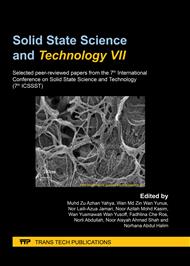[1]
J. Zhang, Y. Shao, C.T. Hsieh, Y.F. Chen, T.C. Su, J.P. Hsu, R.S. Juang, Synthesis of magnetic iron oxide nanoparticles onto fluorinated carbon fabrics for contaminant removal and oil-water separation, Separation and Purification Technology 174 (2017) 312-319.
DOI: 10.1016/j.seppur.2016.11.006
Google Scholar
[2]
Information on https://www.who.int/news-room/fact-sheets/detail/drinking-water.
Google Scholar
[3]
N.K. Srivastava, C.B. Majumder, Novel biofiltration methods for the treatment of heavy metals from industrial wastewater, Journal of hazardous materials 151(1) (2008) 1-8.
DOI: 10.1016/j.jhazmat.2007.09.101
Google Scholar
[4]
C.F. Carolin, P.S. Kumar, A. Saravanan, G.J. Joshiba, M. Naushad, Efficient techniques for the removal of toxic heavy metals from aquatic environment: A review, Journal of Environmental Chemical Engineering 5(3) (2017) 2782-2799.
DOI: 10.1016/j.jece.2017.05.029
Google Scholar
[5]
W.R. Cai, Y.Q. Chen, Y. Liu, X. Jin, Y.Q. Deng, Y.Z. Zhang, J. Zhang, H. Yan, W.L. Gao, J. Mei, W.M. Lau, Fabrication of copper electrode on flexible substrate through Ag+-based inkjet printing and rapid electroless metallization, IEEE Transactions on Components, Packaging and Manufacturing Technology 7(9) (2017) 1552-1559.
DOI: 10.1109/tcpmt.2017.2730483
Google Scholar
[6]
J. Yang, S. Li, Y. Gong, C. He, Q. Zhang, J. Wu, W. Lio, D. Shu, S. Tian, Preferential catalytic ozonation of p-nitrophenol by molecularly imprinted Fe3O4/SiO2 core-shell magnetic composites, Water science and technology 69(1) (2014) 170-176.
DOI: 10.2166/wst.2013.629
Google Scholar
[7]
M.F. Li, Y.G. Liu, S.B. Liu, D. Shu, G. M. Zeng, X.J. Hu, X.F. Tan, L.H. Jiang, Z.L. Yan, X.X. Cai, Cu(II)-influenced adsorption of ciprofloxacin from aqueous solutions by magnetic graphene oxide/nitrilotriacetic acid nanocomposite: competition and enhancement mechanism, Chem. Eng. J. 319 (2017) 219-28.
DOI: 10.1016/j.cej.2017.03.016
Google Scholar
[8]
V.K. Gupta, S. Agarwal, A.K. Bharti, H. Sadegh, Adsorption mechanism of functionalized multi-walled carbon nanotubes for advanced Cu (II) removal, Journal of Molecular Liquids 230 (2017) 667-673.
DOI: 10.1016/j.molliq.2017.01.083
Google Scholar
[9]
M.B. Gumpu, S. Sethuraman, U.M. Krishnan, J.B.B. Rayappan, A review on detection of heavy metal ions in water–an electrochemical approach, Sensors and Actuators B: Chemical 213 (2015) 515-533.
DOI: 10.1016/j.snb.2015.02.122
Google Scholar
[10]
R. Chen, L. Chai, Q. Li, Y. Shi, Y. Wang, A. Mohammad, Preparation and characterization of magnetic Fe 3 O 4/CNT nanoparticles by RPO method to enhance the efficient removal of Cr (VI), Environmental Science and Pollution Research 20(10) (2013) 7175-7185.
DOI: 10.1007/s11356-013-1671-4
Google Scholar
[11]
K.K. Kefeni, T.A. Msagati, B.B. Mamba, Ferrite nanoparticles: synthesis, characterisation and applications in electronic device, Materials Science and Engineering: B 215 (2017) 37-55.
DOI: 10.1016/j.mseb.2016.11.002
Google Scholar
[12]
R.A.S. Azis, M. Hashim, N.M. Saiden, N. Daud, N.M.M. Shahrani, Study the iron environments of the steel waste product and its possible potential applications in ferrites, Advanced Materials Research 1109 (2015) 295-299.
DOI: 10.4028/www.scientific.net/amr.1109.295
Google Scholar
[13]
N. Daud, R.S. Azis, M. Hashim, K.A. Matori, J. Hassan, N.M. Saiden, N.M.M. Shahrani, Preparation and characterization of Sr1− xNdxFe12O19 derived from steelwaste product via mechanical alloying, Materials Science Forum 846 (2015) 403-409.
DOI: 10.4028/www.scientific.net/msf.846.403
Google Scholar
[14]
N. Rosdi, M.S. Mustaffa, N.H. Abdullah, S. Sulaiman, T.T. Ling, Synthesis and characterization of Mg–Ti substituted barium hexaferrite (BaMg 0.6 Ti 0.6 Fe 10.8 O 19 ) derived from millscale waste for microwave application, Journal of Materials Science: Materials in Electronics (2019) 8636-8644.
DOI: 10.1007/s10854-019-01186-3
Google Scholar
[15]
S. Sulaiman, R.S. Azis, I. Ismail, H.C. Man, N.A.A. Nazri, Adsorption potential of magnetite nanoparticles for copper removal from aqueous solution, International Journal of Innovative Technology and Exploring Engineering (IJITEE) 1 (2019) 5424.
DOI: 10.35940/ijitee.a8101.119119
Google Scholar
[16]
P.L. King, M.S. Ramsey, P.F. McMillan, G. Swayze, Laboratory fourier transform infrared spectroscopy methods for geologic samples, in: P. King, M. Ramsey, G. Swayze (eds.), Infrared Spectroscopy in Geochemistry, Exploration, and Remote Sensing, Mineral. Assoc. of Canada, London, ON, 33, 2004, pp.57-91.
DOI: 10.2113/gsecongeo.100.8.1663-a
Google Scholar
[17]
N.A.A. Nazri, R.S. Azis, H.C. Man, I. Ismail, I.R. Ibrahim, Extraction of Magnetite from millscale, International Journal of Engineering and Advanced Technology (IJEAT) 9 (1) (2019) 5902.
Google Scholar
[18]
J.M. Cohen, J. Beltran-Huarac, G. Pyrgiotakis, P. Demokritou, Effective delivery of sonication energy to fast settling and agglomerating nanomaterial suspensions for cellular studies: Implications for stability, particle kinetics, dosimetry and toxicity, NanoImpact. 10 (2018) 81-86.
DOI: 10.1016/j.impact.2017.12.002
Google Scholar
[19]
E. Rahmawati, A. Taufiq, S. Sunaryono, A. Fuad, B. Yuliarto, S. Suyatman, D. Kurniadi, Synthesis of magnetite (Fe3O4) nanoparticles from iron sands by coprecipitation-ultrasonic irradiation methods, J. Mater. Environ. Sci. 9(3) (2018) 155-160.
DOI: 10.26872/jmes.2018.9.1.19
Google Scholar
[20]
R. Reza, C.M. Pérez, C.R. González, H. Romero, P.G. Casillas, Effect of the polymeric coating over Fe3O4 particles used for magnetic separation, Open Chemistry 8(5) (2014) 1041-1046.
DOI: 10.2478/s11532-010-0073-4
Google Scholar
[21]
M.T. Shah, E. Alveroglu, Synthesis and characterization of magnetite nanoparticles having different cover layer and investigation of cover layer effect on the adsorption of lysozyme and bovine serum albumin, Materials Science and Engineering: C 81 (2017) 393-399.
DOI: 10.1016/j.msec.2017.08.033
Google Scholar
[22]
E. Alveroğlu, H. Sözeri, A. Baykal, U. Kurtan, M. Şenel, Fluorescence and magnetic properties of hydrogels containing Fe3O4 nanoparticles, Journal of Molecular Structure 1037 (2013) 361-366.
DOI: 10.1016/j.molstruc.2013.01.017
Google Scholar


